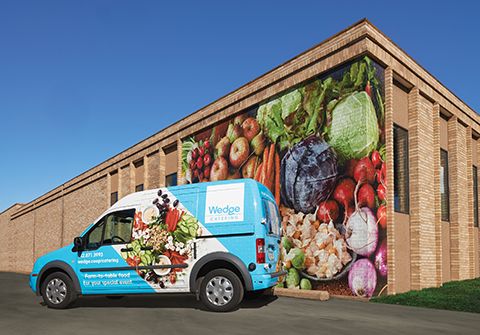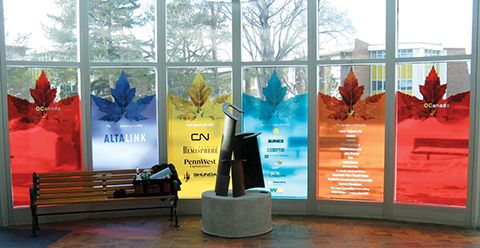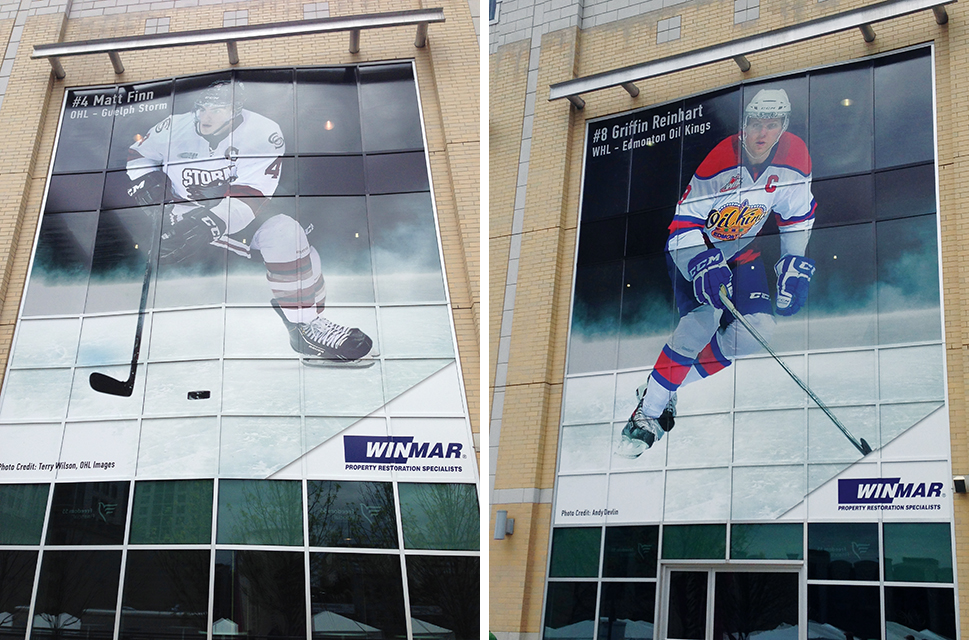Wide-format Printing: How to profit from wrap graphics
by all | 20 July 2015 2:47 pm
 [1]
[1]Photos courtesy 3M Canada
By Jeff Uzbalis
Many commercial printing companies have been entering the wide-format arena in recent years, as the market continues to grow. Most advertisers say wide-format graphics are effective at meeting their goals, so there has been a corresponding increase in spending on out-of-home (OOH) advertising over time.
By way of example, in a study presented in September 2014, approximately 85 per cent of consumers reported they were influenced by in-store graphics when making purchasing decisions, compared to only 37 per cent citing social media as an influence. Other studies have shown how vehicle graphics are the lowest-cost form of advertising, in terms of the investment required and the number of people reached.
OOH is not just billboards, car wraps and point-of-purchase (POP) displays. It also includes event graphics, building wraps and exhibits. Walls, windows and floors—both indoors and outdoors—are all being wrapped with eye-catching graphics in more and more environments, from arenas to museums. InfoTrends, a market research and strategic consulting firm for the digital imaging industry, estimates these applications represent an approximately $10 billion market in the U.S., which translates to an approximately $1 billion market within Canada.
One major reason this market continues to grow is an increasing frequency of graphic updates. Retailers who used to implement décor for five years at a time now change out their graphics every two years or every quarter. Even banks look like retail stores now, with enticing advertising graphics replaced on a seasonal basis.
So, it is little wonder to see this market attracting commercial printing companies, particularly those that are already well-established as retailers’ print vendors. For the most part, however, they are accustomed to imaging on paper, for applications where there is little chance of anything going wrong with their products after they are printed. Some commercial print professionals become aware of the higher profit margins associated with wide-format graphics and race into the market, but end up choosing the wrong materials and/or installing them poorly.
With wide-format media, printing is only the beginning of the process. It is important to understand not just how to create the desired image on the material, but also how to finish, install and eventually remove it. All problems that can occur at these various stages of the process are completely preventable, so long as graphics providers conduct their due diligence upfront, including site inspections.
Windows
Window graphics represent the biggest growth area within the OOH market, as they have proven
a cost-effective method for retail promotions. The aforementioned 2014 study, by 3M, showed they can account for drawing 25 per cent of a store’s traffic.
 [2]
[2]Studies show window graphics can account for drawing 25 per cent of a commercial location’s traffic.
Glass has a high level of surface energy. This makes it easy to stick graphics to a window, but difficult to remove them. With this in mind, permanent adhesives are not recommended. Rather, changeable adhesives are appropriate for short-term graphics, while removable adhesives are suitable for longer campaigns. A recent one-week skating event, for example, needed changeable films for window graphics installed in cold weather at Budweiser Gardens in London, Ont.
There are many possible approaches for window graphics. They may be single- or double-sided; applied to the outer (‘first’) or inner (‘second’) surface of a window; and printed on opaque, translucent or clear film.
The specific approach will depend on the circumstances of the job. With tinted windows, for example, ad graphics will need to be installed on the first surface or they will be darkened by the tint. With double-sided graphics, a blockout film layer is inserted between the two printed films. And perforated films are often required to allow people to see outside from inside a building.
Walls
A wall provides a focal point to promote a brand or customize a space, whether with short-term advertising or long-term design features. While these types of graphics have become very common today, they can be the most difficult applications to specify products for, due to the high level of variability between different walls.
Each wall will need to be tested for adhesion because different surfaces and paints have different characteristics and textures. Paints low in volatile organic compounds (VOCs), for example, have become popular for environmental, health and safety reasons, but it is inherently more difficult to adhere printed graphics to walls that have been coated with these paints.
Rough surfaces like brick and stone can only be wrapped with special, conformable films, which fortunately have become more common and faster to use. At the annual Scotiabank Contact Toronto Photography Festival, for example, wrapping an exterior wall of the Museum of Contemporary Canadian Art (MOCCA) has become faster each year.
Another issue is glare, which is influenced by a film’s gloss level. Most graffiti-resistant overlaminates are glossy, for example, while interior wall graphics typically require matte or semi-matte finishes. Given how overlaminates can change the appearance of a wall graphic, including its colours, it is important to get the client to sign off not only on the original image file, but also on its laminated appearance.
 [3]
[3]Glass has a high level of surface energy, which makes it easy to stick graphics to a window, but difficult to remove them.
Floors
The wide-format printing industry has seen a surge in floor graphics in the last two to three years. As a form of advertising, this application has certainly proven effective, with 3M’s 2014 study showing 64 per cent of people stop to read floor graphics and associated sales increase by 17 per cent.
With today’s variety of films, graphics can be applied not only to smooth floors, but also to carpets and outdoor asphalt or concrete surfaces. Again, it is important to test a film for the strength of adhesion with a given floor.
The films are also laminated with a rough texture to ensure they are safe to walk on without slipping. The adhesive must also be removable without leaving residue behind.
Redefining graphics shops
The graphics industry has transitioned to ‘just in time’ printing and one-to-one marketing, with advertisers ordering new graphics more frequently for more customized campaigns. The number of digitally printed applications has also exploded, putting pressure on providers who feel they need to be able to wrap everything.
In response, many sign shops, screenprinting companies and other traditional businesses are redefining themselves as print service providers (PSPs) or ‘digital service bureaus,’ focusing on value-added visual communications consulting, rather than just printing. As they move from mass production to customization, they are supported by automated technology, which has greatly reduced the amount of labour needed to create each graphic application.
To produce outdoor-durable graphics, a shop needs a piezoelectric inkjet printer, which may use solvent-based, eco-solvent, ultraviolet-curable (UV-curable) or durable aqueous ‘latex’ inks. All of these printers and inks offer their own strengths and limitations. Customers do not care which technology is used, of course, so long as they can buy good quality, on time, at a reasonable price.
A shop also needs a digital front end, pre-press software, a laminator, a cutter and an inventory of media, not to mention well-trained staff, salespeople and graphic installers. Professional-quality installation is especially important because, with a lower barrier to entry, anyone can get into the business today and start printing graphics, so there is a lot of competition.
 [4]
[4]These graphics were printed on changeable films for installation in cold weather for a one-week event.
Getting the mix right
Common pitfalls relating to graphic installation include not visiting the site to take proper measurements and photos, not testing substrates properly and a lack of installation skill or experience. And as mentioned, PSPs often select the wrong printable film on the basis of price.
Calendered films, for example, will shrink over time. In this sense, they could be compared to pizza dough, which shrinks back after it is rolled out flat. Calendered films are less expensive to manufacture and buy than cast films, which are more like pancake batter, as they will not shrink back over time.
Adhesives also vary. As mentioned, they may be permanent, changeable (i.e. removable without heat) or removable (i.e. requiring heat for removal), but they are also either pressure-sensitive or pressure-activated. A ‘conformable’ adhesive uses air release capabilities to prevent bubbles during installation.
The cost of poor film and adhesive selection is a waste of ink and time, given the subsequent difficulties in both installation and removal. This is why testing is essential.
Another important part of the graphics is lamination, which not only affects an image’s look and feel, but also its durability and ease of removal, depending on its compatibility with the ink and film. Failures relating to incompatibility will usually show up right away. With this in mind, graphics providers should select their films, inks and laminates carefully, checking their warranties; in some cases, a matched component system (MCS) shares a single warranty.
Further, if installation expertise is not a print shop’s strong suit, it is possible to reach out to fully trained and accredited graphic installers who are not the shop’s direct competitors (i.e. they do not print). This is especially common practice with vehicle wraps, where application and installation services tend to be outsourced to independent specialists.
The market will continue to change. The key to success for professional graphics providers will be continual education, so as to identify new market opportunities in new projects and processes as they arise.
Jeff Uzbalis is a wide-format commercial graphic applications specialist for 3M Canada. For more information, contact him at juzbalis@mmm.com[5].
- [Image]: http://www.signmedia.ca/wp-content/uploads/2015/07/Envision_Wedge-Wall-Van.jpg
- [Image]: http://www.signmedia.ca/wp-content/uploads/2015/07/Window_StudioTwentyOne.jpg
- [Image]: http://www.signmedia.ca/wp-content/uploads/2015/07/3M-8150-windows.jpg
- [Image]: http://www.signmedia.ca/wp-content/uploads/2015/07/edit11.jpg
- juzbalis@mmm.com: mailto:juzbalis@mmm.com
Source URL: https://www.signmedia.ca/wide-format-printing-how-to-profit-from-wrap-graphics/